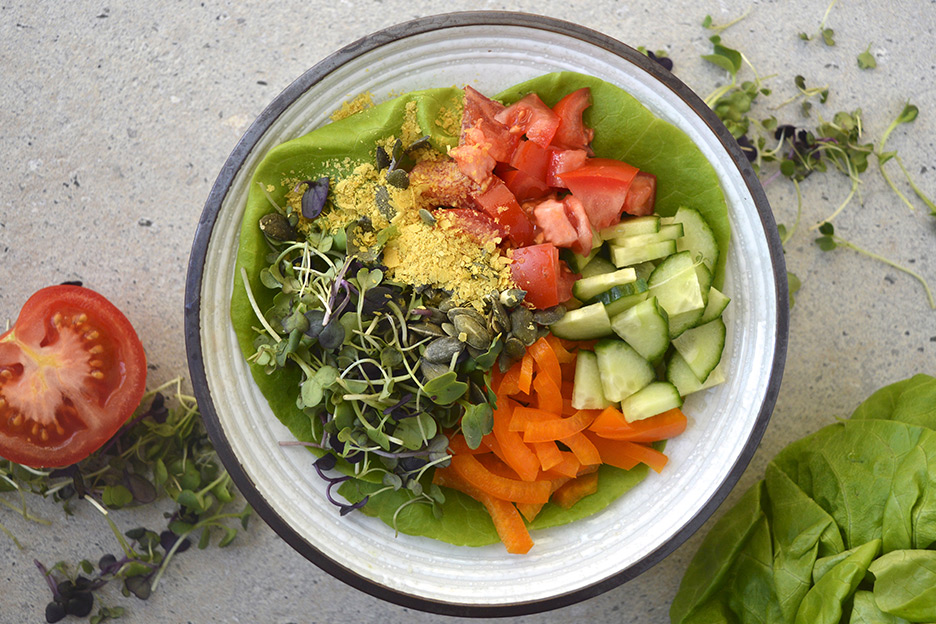There’s something intriguing about how a woman’s body is programmed for life, but the journey is marked by occasional discomfort, often minor, sometimes less so. That’s certainly the case when it comes to hot flashes, a phenomenon that usually arises with the onset of menopause. The good news, ladies, is that you can calm down your internal thermostat by adopting certain eating habits.

First, a few definitions
A woman officially enters menopause one year after her last menstruation [1]. The much dreaded hot flashes may sometimes appear a few years before this juncture in a woman’s life, during a period known as perimenopause, a time characterized by irregular menstruation.
That said, it is normally during the first 12 months of menopause that hot flashes are at their peak. Close to three quarters of women feel their effects [2], and the phenomenon can last 4 to 5 years, sometimes even longer [3].
What is commonly called a hot flash is medically known as a vasomotor symptom (say what?). The phenomenon is not completely understood even today, but it is initiated by a drop in the body’s estrogen level, a female reproductive hormone produced primarily in the ovaries. A menopausal woman therefore undergoes a kind of estrogen withdrawal, and a series of hormonal and chemical shifts occur in her body.
In turn, these changes come pounding at the door of the hypothalamus, which unfortunately just happens to be the brain’s centre of temperature regulation. Thrown out of whack by the intrusion, the hypothalamus overreacts to slight increases in temperature and jump starts the body’s systems to try and cool down at all costs (even if it was perfectly comfortable at the time). [4].
As part of that reaction, the peripheral bloodstream (which circulates just under the skin) goes into overdrive to try and dissipate this phantom excess of heat and bring the body’s core temperature back to “normal”. The woman experiences a surge of heat, blushes intensely, feels her heart rate go up and starts to sweat: these are the vasomotor symptoms. [5].
Hot flashes do the most damage when they occur at night, disrupting a woman’s sleep. The irritability that often accompanies menopause can more often be traced back to a terrible night’s sleep than to hormonal changes.
In short, hot flashes are not inconsequential. They can significantly alter a perimenopausal or menopausal woman’s quality of life, so it’s vital to find ways to sooth these symptoms.
- [1] Harlow et al. 2012
- [2] Menopause FAQS: Hot Flashes
- [3] Marc A. Fritz MD, 2010
- [4] Idem
- [5] Menopause FAQS: Hot Flashes

Nutrition to the rescue?
It is critical to develop or maintain healthy lifestyles that include balanced nutrition, ample hydration, regular physical activity, quitting smoking as well as slimming down or maintaining a healthy weight.
Until now, the most effective treatment for hot flashes is hormonal therapy [1] as prescribed by a physician. There are, however, some alternative or complementary methods that are worth a look.
First, it’s important to develop or maintain healthy lifestyles that includes a balanced nutrition, ample hydration, regular physical activity, quitting smoking as well as slimming down and maintaining a healthy weight. [2]. Once these main areas are covered, consider these options:
- Cold drinks: sipping a cold beverage won’t make your vasomotor symptoms go away but will be hugely refreshing when hot flashes occur. Unsweetened drinks are preferred: flavoured water, herbal iced tisanes, sparkling water, etc.
- Soy: soy is a natural source of isoflavones, a type of phytoestrogen. Phytoestrogens are plant molecules whose structure is strangely similar to female estrogen. Popular belief has it that consuming soy helps reduce hot flashes given the “hormonal” action of the isoflavones. This assertion has been challenged by science, however, which has not succeeded in proving the effects of the isolated compounds let alone the foods that contain them. [3].
- Flax: like soy, flaxseed contains phytoestrogens, mostly of the lignan type. Here again, the effects of these compounds and their parent flaxseeds have not been proven to combat hot flashes [4], despite all the buzz on the subject.
All the same, a number of women have reported a positive effect (possibly placebo) after starting to eat more soy. If you have no contraindications to consuming soy, such as an allergy or a history of hormonodependant cancer, you have nothing to lose by incorporating these highly nutritious foods in your diet, which include tofu, tempeh, edamame and soy beverages.
As for flaxseed, it’s a locally produced food that contains, among other good things, omega-3s and soluble fibres that are heart healthy. Adding ground flaxseed to muffins, cookies, oatmeal and smoothies is beneficial, whether or not it helps reduce vasomotor symptoms.
- Omega-3s: Omega-3s are healthy fats that are found in certain foods and on the pharmacy shelf in the form of supplements. Many women have seen an improvement in their symptoms when they begin taking Omega-3 supplements, despite the fact studies are unanimous in not being able to establish a link with improved vasomotor symptom management. [5]. So there’s no harm in trying this avenue to see if it might have a beneficial effect on your body. In any case, adding more Omega-3s (fatty fish, flaxseed, chia seed, walnuts, canola oil, etc.) to your diet can have nothing but a positive effect on your health in general.

Foods to avoid?
There are effectively certain beverages and foods which, if consumed in large quantities, can actually exacerbate hot flashes. The best plan, therefore, is to proceed with moderation while listening to your body, without eliminating these items entirely.
- Alcohol: alcoholic drinks have a vasodilatory effect that amplifies the hot flash sensation. Choose smaller serving sizes or go with drinks that have little or no alcohol content: de-alcoholised beer or wine, mocktails, kombucha, etc.
- Caffeine: caffeine, which is obviously found in coffee but also in certain teas, chocolate and cola-type soft drinks, is a stimulant which speeds up the heart rate and vasodilation. Why not try having a decaf for your afternoon coffee?
- Spicy foods: it will come as no surprise that spicy foods make you feel hot, something you want to avoid when you are already stricken with bouts of hot flashes. So try going easy on the chili peppers and hot sauce.
Every woman is unique!
Finally, in your fight against hot flashes, with or without hormonotherapy, the best advice is to adopt healthy lifestyle habits. Some foods can also give you a little leg up, without promising any miracles.
Every woman is unique, and different approaches will have a different effect on each of us. With a little help from your doctor, see what works best for you and your personal situation.
References
- Harlow et al. 2012. EXECUTIVE SUMMARY of STRAW+10: Addressing the Unfinished Agenda ofStaging Reproductive Aging. Climacteric. 15(2): 105–114.
- The North American Menopause Society, Menopause FAQs : Hot Flashes, disponible en ligne (8 juin 2018).
- Marc A. Fritz MD. Clinical Gynecologic Endocrinology and Infertility, 8th Edition, Wolters Klewer Health, Lippincott Williams & Wilkins, 2010.
- Managing Menopause, Journal of Obstetrics and Gynaecology Canada, September 2014, available online (June 8, 2018).
- Society of Obstetricians and Gynaecologists of Canada, Canadian Consensus on Female Nutrition: Adolescence, Reproduction, Menopause and Beyond: June 2016, available online (June 8, 2018).
- Cohen et al. 2014. Efficacy of Omega-3 Treatment for Vasomotor Symptoms: A Randomized Controlled Trial. Menopause. 21(4): 347–354.
